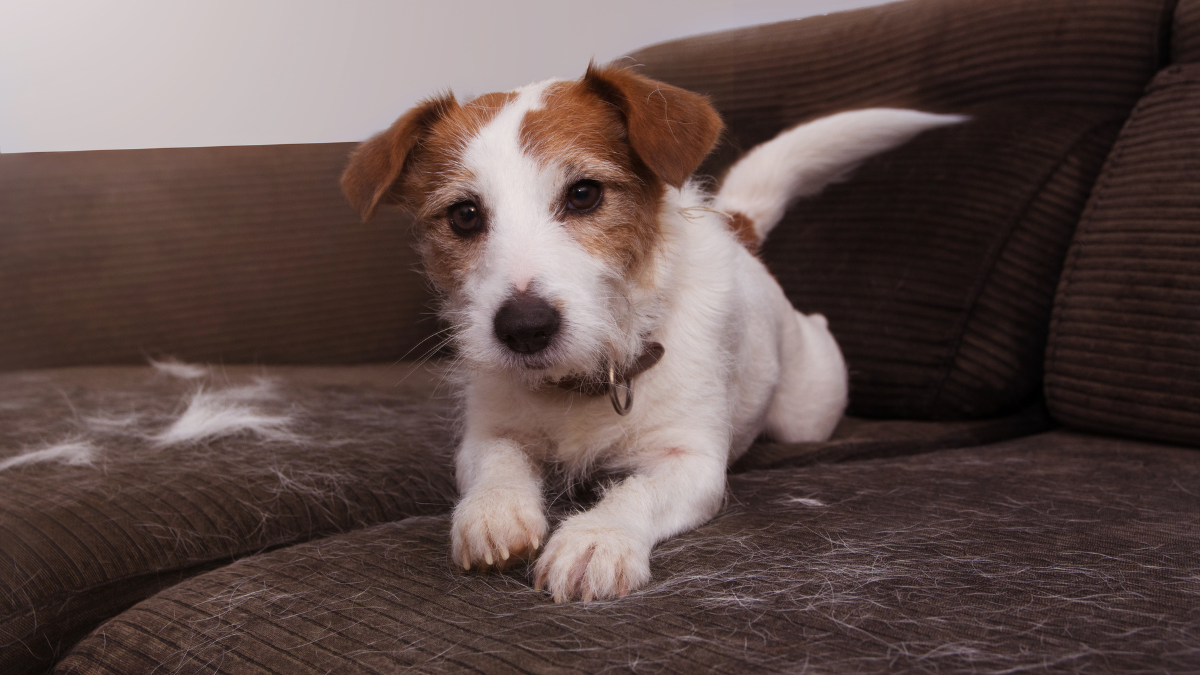Shedding 101: It’s Not a Flaw, It’s a Feature | Why Do Dogs Shed So Much?
Let’s get one thing straight: shedding isn’t your dog’s passive-aggressive way of redecorating your home. It’s as natural as humans blinking or breathing. Dogs shed to replace old fur, regulate body temperature, and adapt to seasonal shifts. Think of it like swapping out a winter coat for a breezy summer shirt—except your dog’s “coat” ends up on your couch, clothes, and somehow inside your toaster.
My dog, for instance, could rival a snowstorm during shedding season. At first, I mistook his fur explosions for a grooming failure, but I soon realized it was just his body’s way of staying healthy. Even breeds marketed as “hypoallergenic” shed a little—they’re just sneakier about it.
Why Shedding Should Matter to You
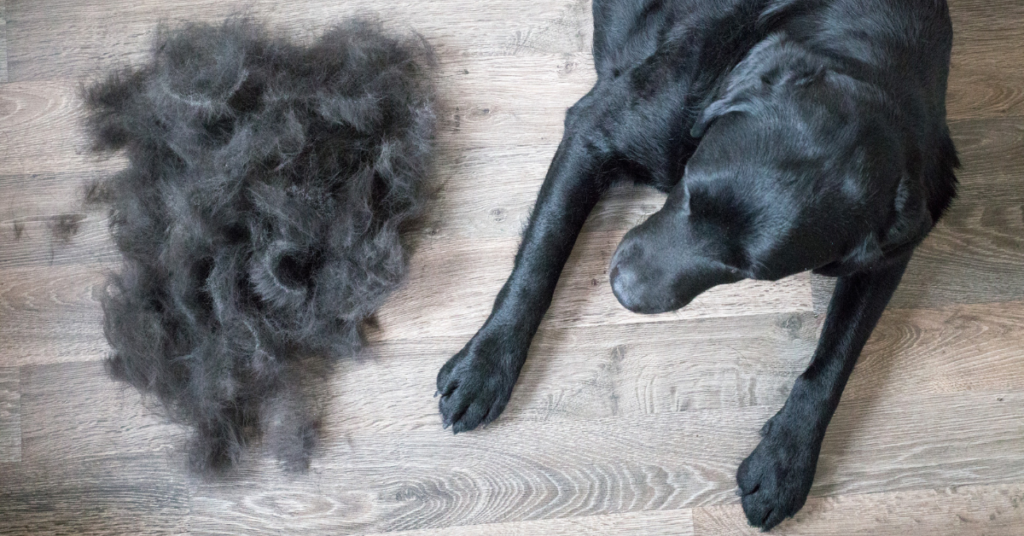
If you’ve ever wondered, “Is this much shedding normal?” you’re not alone. Shedding isn’t just a cleaning hassle—it’s a health barometer. Excessive shedding can hint at allergies, stress, poor diet, or hidden medical issues. On the flip side, seasonal shedding is usually harmless (though no less annoying).
Take it from me: I once blamed my dog’s sudden fur loss on a new shampoo, only to discover he was stressed from a recent move. Tracking his shedding patterns helped me address the root cause, not just the symptoms. Understanding shedding isn’t just about saving your vacuum cleaner—it’s about catching problems early, like skin infections or thyroid imbalances, before they spiral.
What’s Ahead: Your Roadmap to Less Fur, More Peace
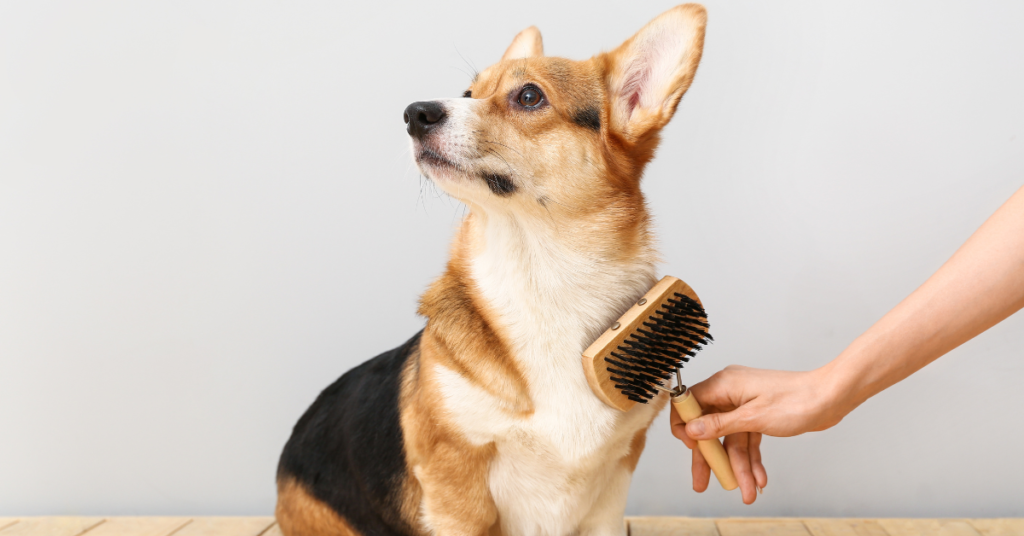
Ready to tackle the fluff? In this guide, we’ll cover:
- The science of shedding: How your dog’s hair cycle works (spoiler: it’s not random!).
- Top triggers: From seasonal changes to that “harmless” scented candle.
- Proven solutions: Brushing hacks, diet tweaks, and stress-busters I’ve tested on my own fur-covered life.
You’ll learn why shaving your dog is a bad idea (yes, even in summer), how to spot “normal” vs. “worrisome” shedding, and why that pricey salmon oil supplement might be worth every penny. Let’s turn shedding from a headache into a manageable—and even understandable—part of life with your dog.
The Science Behind Dog Shedding: It’s All About the Hair Cycle

The 4 Stages of Your Dog’s Hair Growth (Yes, It’s a Cycle!)
Let’s geek out for a second: your dog’s fur doesn’t just fall out randomly. It follows a carefully choreographed cycle, like a never-ending Broadway show with four acts:
- Anagen (Growth Phase): This is when new hair sprouts and grows. Think of it as your dog’s coat hitting the gym—bulking up for winter or summer.
- Catagen (Transition Phase): Growth slows, and the hair follicle starts to shrink. It’s like your dog’s fur is saying, “Okay, I’m done here.”
- Telogen (Resting Phase): The hair stops growing but stays attached. Imagine it lounging in a hammock, not doing much.
- Exogen (Shedding Phase): The hair finally lets go, making room for new growth. This is when your floors, clothes, and air vents become collateral damage.
My dog’s shedding used to baffle me until I learned this cycle. For example, during spring, his Exogen phase goes into overdrive, leaving tufts of fur everywhere. But knowing why it happens—to prepare for a lighter summer coat—made me less likely to side-eye him for ruining my sofa.
Why Shedding Is Actually a Good Thing
Shedding isn’t a design flaw—it’s survival mode. Here’s why:
- Temperature Control: Dogs don’t have the luxury of swapping sweaters for tank tops. Shedding helps them ditch insulation in summer and grow it back in winter. My dog, who thrives in cold weather, starts shedding his thick undercoat the moment the thermostat hits 70°F. If he didn’t, he’d overheat on our walks.
- Out With the Old: Damaged or dead hair has to go. Imagine wearing a frayed sweater 24/7—shedding keeps your dog‘s coat healthy and functional.
Fun fact: Double-coated dogs (you know, the ones that leave enough fur to stuff a mattress) shed more intensely because they’re built for extreme weather. Their undercoat acts like thermal underwear, and when seasons shift, it’s eviction time.
Not All Dogs Shed the Same Way
Here’s where things get interesting. Shedding isn’t one-size-fits-all:
- Heavy Shedders: Often dogs with double coats or dense undercoats. They’re the “blow-dryer of fur” types, releasing clouds of hair during seasonal shifts.
- Low-Shedding Dogs: Typically have hair that grows continuously (like human hair) instead of a seasonal coat. But don’t be fooled—they still shed, just in smaller amounts.
When I adopted my dog, I didn’t realize his coat type meant I’d need a vacuum upgrade. His double coat requires weekly brushing to manage the shedding, while my friend’s low-shedding pup gets by with a quick monthly groom. Knowing your dog’s coat type is like knowing their love language—it saves everyone’s frustration.
Practical Takeaway:
- Brush smarter, not harder: Use a de-shedding tool during the Exogen phase to catch loose fur before it hits your floors.
- Seasonal awareness: Expect heavier shedding in spring/fall—it’s normal, not a crisis.
What Makes Dogs Shed More? Surprising Triggers You Need to Know
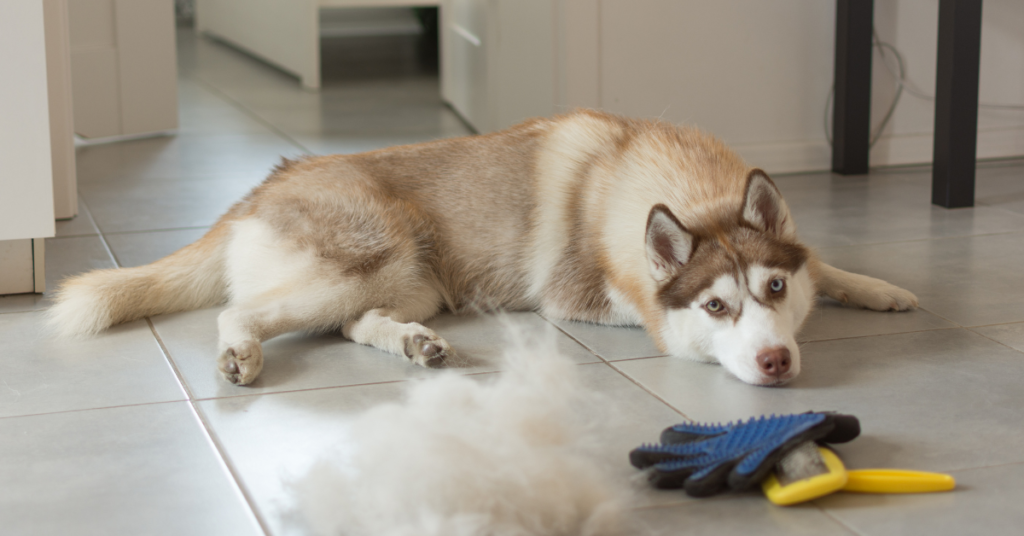
Seasonal Shedding: When Your Dog Becomes a Walking Snow Globe
Every spring, my dog transforms into a furry tornado. I once joked that he could single-handedly supply stuffing for a pillow factory—until I learned about “blowing coat.” This seasonal shed helps dogs adapt to temperature shifts. In spring, they ditch their thick winter undercoat for a lighter summer layer. In the fall, they bulk up again.
But here’s the kicker: indoor dogs living in climate-controlled homes might shed year-round. Artificial lighting and steady temps confuse their natural cycle. My dog, for instance, sheds moderately all year but goes full-on “fluff-nado” in April. If your pup’s shedding seems endless, blame your thermostat, not them.
Pro Tip:
- Brush daily during seasonal sheds to speed up the process.
- Use a high-velocity dryer (if your dog tolerates it) to blast loose fur outdoors.
Stress, Products, and Hidden Hazards in Your Home
Shedding isn’t always about biology. Stress—yes, dogs get stressed, too—can trigger hair loss. When I moved apartments last year, my dog left clumps of fur everywhere for weeks. The chaos of boxes, strangers, and new smells overwhelmed him. Even subtle changes, like a new pet or a noisy neighbour, can cause shedding spikes.
Environmental factors also play a role:
- Harsh shampoos: That lavender-scented wash? It might dry out your dog’s skin, leading to more shedding.
- Household cleaners: Chemical residues on floors or bedding can irritate their coat.
- Allergens: Dust mites or pollen hitchhike indoors and aggravate sensitive dogs.
After switching to oatmeal-based shampoo and natural cleaners, my dog’s shedding calmed down. Lesson learned: what’s safe for humans isn’t always pup-friendly.
You Are What You Eat: How Diet Fuels Shedding
I used to feed my dog budget kibble, thinking, “How different could premium food be?” Turns out, very. His coat went from dull and shedding-prone to glossy (well, glossy-ish) after I switched to a diet rich in omega-3s and high-quality protein.
Why nutrition matters:
- Omega fatty acids: Found in fish oil or flaxseed, they strengthen hair follicles.
- Protein: Hair is mostly protein—low-quality diets lead to brittle fur.
- Hydration: Dehydrated skin = more shedding. My dog now gets a splash of broth in his water bowl to encourage drinking.
Red flag: If your dog’s shedding comes with dandruff or a greasy coat, their diet might lack key nutrients. Ask your vet about supplements—I added a salmon oil pump to my dog’s meals, and it made a noticeable difference.
Practical Takeaways:
- Seasonal prep: Stock up on lint rollers and plan deep-cleaning days during peak sheds.
- Stress audit: Minimize changes in routine and create a “safe zone” (like a cozy crate) during chaotic times.
- Food upgrades: Look for keywords like “skin and coat formula” or “omega-rich” on labels.
When Shedding Signals a Problem: Health Issues to Watch For
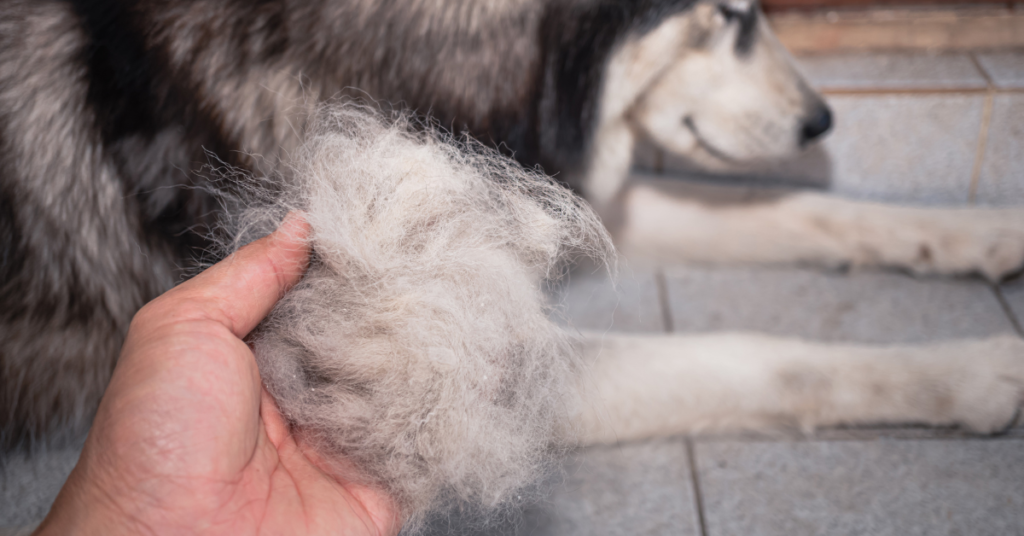
Allergies, Parasites, and Skin Infections: The Usual Suspects
Let’s be real: sometimes shedding isn’t just “seasonal fluff.” It’s a red flag. A few years back, my dog started shedding like he was auditioning for a hair-loss commercial. Turns out, he’d picked up fleas during a playdate. Those tiny pests irritated his skin, causing frantic scratching and a fur exodus.
Common culprits:
- Allergies: Food, pollen, or even your new floor cleaner can trigger itchiness and hair loss. My neighbour’s dog once shed buckets because of a chicken allergy—switching to a novel protein (like a kangaroo) fixed it.
- Parasites: Fleas, mites, or ticks turn your dog’s coat into a battleground. Check for “flea dirt” (tiny black specks) or excessive scratching.
- Infections: Bacterial or fungal issues, like ringworm, create patchy shedding. If your dog’s skin looks scaly or smells funky, it’s vet o’clock.
Pro Tip:
- Run a flea comb through their fur monthly—even if you don’t see pests.
- For allergies, try an elimination diet (start with bland meals like rice + turkey) to pinpoint triggers.
Hormonal Havoc: Thyroid Issues and Cushing’s Disease
Hormones are sneaky little troublemakers. Take hypothyroidism: a sluggish thyroid gland can slow metabolism and turn your dog’s coat into a dry, shedding mess. A friend’s dog gained weight and shed relentlessly for months before bloodwork revealed the issue. Daily medication brought back her glossy coat.
Then there’s Cushing’s disease, where excess cortisol thins the skin and weakens hair follicles. Symptoms include excessive thirst, potbelly, and—you guessed it—shedding. My aunt’s terrier had Cushing’s; managing it required meds and regular vet checks, but it stopped the fur apocalypse.
Key Signs:
- Sudden weight changes + shedding.
- Symmetrical bald patches (common with hormonal issues).
When to Sound the Alarm: Vet-Worthy Symptoms
Not all shedding is created equal. Here’s when to swap the lint roller for a vet visit:
- Bald spots or thinning fur: Especially if paired with redness or scabs.
- Behaviour changes: Lethargy, appetite shifts, or excessive thirst.
- Itch overload: Constant licking, chewing, or rolling on carpets.
I learned this the hard way when my dog’s “harmless” shedding escalated to raw, irritated skin. A vet diagnosed a bacterial infection, and antibiotics cleared it up in weeks. Trust your gut—if something feels off, it probably is.
Action Plan:
- Snap photos of problem areas to show your vet.
- Track symptoms (e.g., “shedding spiked after switching kibble”).
- Ask about blood panels or skin scrapes to rule out hidden issues.
Practical Takeaway:
- Monthly Checkups at Home: Feel for lumps, bumps, or hot spots while brushing.
- Avoid DIY Fixes: Skip internet hacks like essential oils for fleas—they can worsen irritation.
Taming the Fur Tornado: Practical Ways to Manage Shedding
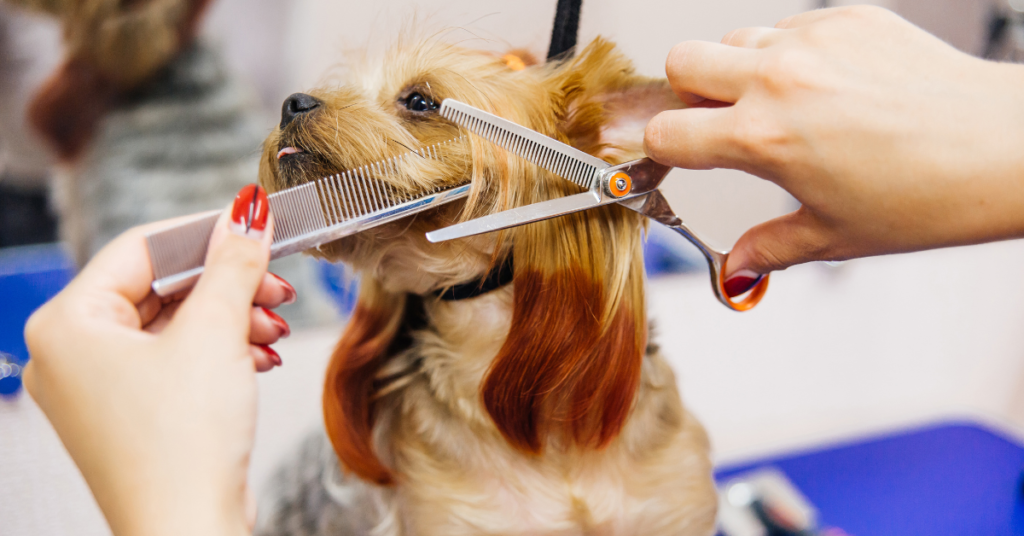
Hacks That Actually Work
Let’s talk about brushes—because not all are created equal. Years ago, I bought a cheap slicker brush that my dog treated like a mortal enemy. It tugged his fur and made shedding worse. Then, I discovered the magic of undercoat rakes and de-shedding tools. These gadgets reach deep into his coat to pull out loose hair before it hits your floors.
My go-to routine:
- Daily brushing during peak shedding seasons (yes, daily—it’s worth it).
- Bathing every 4–6 weeks with an oatmeal shampoo to soothe his skin.
- Post-bath blowout: Use a pet dryer on low heat to blast away loose fur.
Fun fact: My dog now loves grooming because I paired it with treats. A lick mat smeared with peanut butter keeps him distracted while I work through his coat.
Food Fixes: How Diet Can Curb Shedding
I used to think my dog’s diet only affected his energy levels. Boy, was I wrong? After switching to a high-quality kibble packed with salmon and omega-3s, his shedding dropped by half. His coat went from “scraggly stray” to “Instagram influencer” status.
Diet upgrades that matter:
- Omega fatty acids: Fish oil supplements or flaxseed added to meals.
- Hydration hacks: Mixing water or bone broth into kibble to plump up his skin.
- Protein power: Opting for recipes where real meat (not “meal”) is the first ingredient.
When I introduced a probiotic into his diet, his digestion improved—and so did his coat. Less shedding, fewer tummy issues. Win-win.
Home Defense: Keeping Fur Out of Every Crevice
I once found dog hair inside a sealed jar of pasta sauce. True story. Here’s how I declared war on fur:
- Robot vacuum: Runs daily to tackle tumbleweeds.
- Rubber broom: Grabs hair from carpets better than my old vacuum.
- Air purifier: Traps floating fur and dander (bonus: fewer allergies!).
For furniture, I splurged on machine-washable covers. When my dog claims the couch, I toss the covers in the wash instead of battling lint rollers.
Pro Tip: Keep a “fur station” by the door—a basket with a brush, lint roller, and treats—for quick clean-ups after walks.
The One Thing Not to Do (Trust Me)
Shaving your dog to “stop shedding” is like cutting your hair to sweat less—it doesn’t work. My cousin shaved her double-coated dog, and his fur grew back patchy and uneven. Worse, he struggled to regulate his temperature.
Instead:
- Trim long hair around paws and ears for hygiene.
- Leave the full coat intact—it protects against sunburn and insects.
Final Takeaways:
- Consistency beats intensity: Five minutes of daily brushing > one marathon session.
- Invest in tools: A 20desheddingbrushsaves20desheddingbrushsaves200 in ruined sweaters.
- Think beyond fur: Hydration, diet, and stress all play a role.
Shedding Myths Busted: Separating Fact From Fiction

Myth 1: “Shaving Your Dog Stops Shedding”
Let’s kick this one to the curb. Shaving your dog doesn’t stop shedding—it just creates shorter, pricklier hair that’s harder to clean up. Worse, it can ruin their coat’s natural insulation and sun protection.
I learned this the hard way when a groomer talked me into shaving my dog during a summer heatwave. His fur grew back unevenly, and he actually seemed hotter because his double coat couldn’t regulate temperature properly. Now, I only stick to trimming paw pads and sanitary areas.
The truth:
- Shaving can lead to skin irritation, sunburn, and permanent coat damage.
- Focus on brushing out the undercoat instead of cutting it off.
Myth 2: “Hypoallergenic Dogs Don’t Shed”
Newsflash: “Hypoallergenic” is marketing fluff. While some breeds shed less (looking at you, poodle mixes), all dogs shed. The difference? Low-shedding dogs release less dander—the real trigger for allergies—but they still drop hair.
My friend’s “hypoallergenic” dog left enough fur on my couch to knit mittens. She was shocked, but I reminded her no dog is truly dander-free.
The truth:
- Regular baths and air purifiers reduce allergens more than breed selection.
- If allergies are a concern, spend time with a dog before adopting.
Myth 3: “Bathing Your Dog More Often Reduces Shedding”
Washing your dog weekly won’t make them shed less. In fact, overbathing strips natural oils, leading to dry skin and—wait for it—more shedding.
I once fell for this myth and bathed my dog every Sunday. His coat became brittle, and he started shedding like a stressed-out squirrel. Now, I bathe him monthly with a moisturizing shampoo and rely on brushing to manage his fur.
The truth:
- Bathing frequency depends on breed and lifestyle (e.g., mud-loving dogs need more washes).
- Always use a dog-specific shampoo—human products are too harsh.
Myth 4: “Shedding Is Only Seasonal”
If your dog sheds year-round, don’t panic—it’s normal for many breeds. Indoor dogs, especially those exposed to artificial light and heating, often shed consistently because their bodies don’t register seasonal cues.
My dog sheds lightly all year but goes full “shedzilla” in spring. My neighbour’s indoor-only pup, however, drops fur like clockwork every 8 weeks. Both are healthy—their environments just affect their cycles differently.
The truth:
- Consistent shedding is a health issue unless paired with symptoms like itching or bald spots.
- Adjust grooming routines based on your dog’s unique pattern.
Myth 5: “Supplements Can Stop Shedding Completely”
Fish oil and biotin supplements help reduce shedding, but they won’t eliminate it. Shedding is a natural process—you’re aiming to manage it, not erase it.
I added omega-3 supplements to my dog’s diet, and while his coat got shinier, he still left fur on my car seats. It’s like taking vitamins for stronger nails—they improve quality, but you’ll still trim them.
The truth:
- Supplements support skin and coat health but aren’t a magic fix.
- Pair them with good grooming and diet for best results.
Practical Takeaways:
- Myths are sneaky: Always cross-check “quick fixes” with your vet or trusted sources.
- Embrace the fluff: Shedding is part of dog ownership—manage it, don’t fight it.
Conclusion: Embracing the Fluff (Without Losing Your Mind)
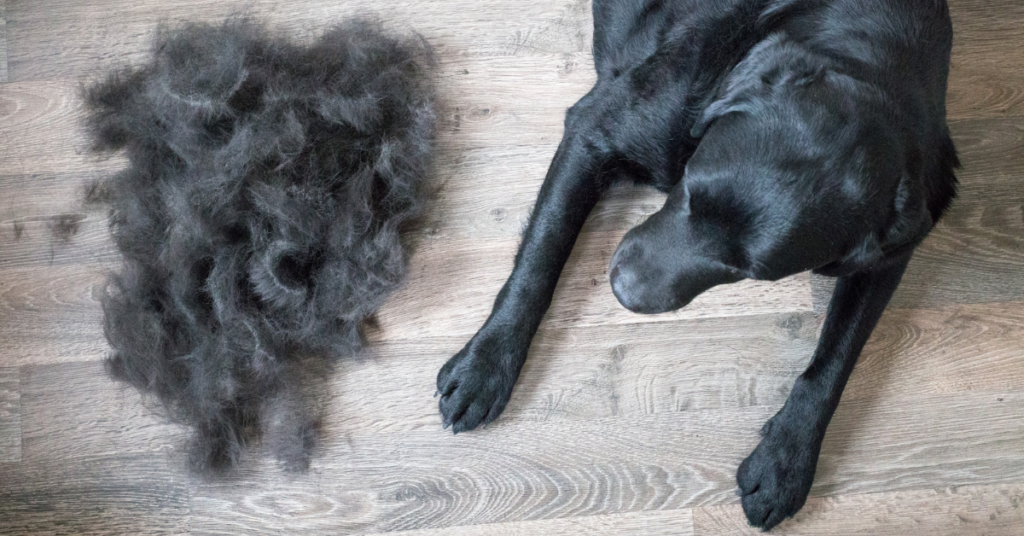
Shedding Isn’t the Enemy—It’s Just Part of the Deal
Let’s be honest: no one adopts a dog thinking, “I can’t wait to spend my weekends vacuuming fur out of the air vents!” But here’s the thing—shedding isn’t a problem to solve. It’s a natural, non-negotiable part of life with a dog. My journey from “fur-phobic” to “fur-accepting” wasn’t easy. There were days I considered buying stock in lint rollers and moments I cursed the invention of hardwood floors. But learning why my dog sheds—and how to work with it instead of against it—changed everything.
Think of shedding like laundry: you’ll never be “done,” but with the right routine, it stops feeling overwhelming.
Your Dog’s Coat Is a Wellness Barometer
Shedding isn’t just about fur—it’s a conversation. A healthy coat reflects good nutrition, low stress, and a comfy environment. When my dog’s shedding spiked last year, it wasn’t a grooming fail; it was his way of saying, “Hey, maybe lay off the cheap treats?” Small tweaks, like upgrading his food or adding a calming supplement during fireworks season, made a world of difference.
Remember:
- Regular vet checkups catch hidden issues early.
- Track patterns (e.g., “shedding peaks after vet visits”) to personalize care.
Final Tips for a (Mostly) Fur-Free Life
Here’s what I wish I’d known sooner:
- Brushing > Cleaning: Spend 5 minutes a day brushing your dog, and you’ll save 30 minutes scrubbing fur off your couch.
- Embrace the Tools: A rubber broom, robot vacuum, and air purifier are your new best friends.
- Celebrate Progress, Not Perfection: My dog will never be fur-free, but he’s healthy, happy, and worth every lint roller sheet.
One Last Story:
The first time my dog’s fur turned up in my work bag during a big meeting, I was mortified. Now? I laugh it off. That fur is proof of hikes we’ve taken, naps we’ve shared, and a bond that’s stronger than any stain remover.
So yes, dogs shed—a lot. But with patience, the right strategies, and a sense of humour, you’ll stop seeing fur as a nuisance and start seeing it as love confetti.
🐾 Pawsitive Vibes: You’ve got this!
FAQs:
1. Why do dogs shed so much?
Dogs shed to replace old/damaged fur, regulate body temperature, and adapt to seasonal changes. It’s a natural process tied to their hair growth cycle.
2. Do all dogs shed seasonally?
No! Double-coated breeds shed heavily in spring/fall (“blowing coat”), while indoor dogs may shed year-round due to artificial light and stable temperatures.
3. When should I be worried about shedding?
If shedding comes with bald spots, redness, itching, or behavior changes (lethargy, appetite loss), consult a vet. It could signal allergies, parasites, or hormonal issues.
4. How often should I brush my dog?
During peak shedding seasons, brush daily. For low-shedding breeds, weekly is enough. Use a deshedding tool for undercoats and a slicker brush for top layers.
5. Can diet really reduce shedding?
Yes! Omega-3 fatty acids (fish oil) and high-quality protein strengthen hair follicles. Hydration and avoiding filler-heavy foods also minimize excessive shedding.
